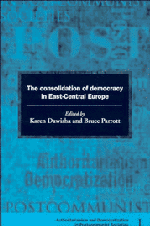Book contents
- Frontmatter
- Contents
- List of tables
- List of contributors
- Preface
- 1 Perspectives on postcommunist democratization
- 2 Democratization and political participation: research concepts and methodologies
- 3 Democratic consolidation in Poland after 1989
- 4 Party politics and political participation in postcommunist Hungary
- 5 Democratization and political participation: the experience of the Czech Republic
- 6 Democratization and political participation in Slovakia
- 7 Democratization and political participation in postcommunist societies: the case of Latvia
- 8 Democratization in Lithuania
- 9 Democratization and political development in Estonia, 1987–96
- Appendix
- Index
2 - Democratization and political participation: research concepts and methodologies
Published online by Cambridge University Press: 01 June 2011
- Frontmatter
- Contents
- List of tables
- List of contributors
- Preface
- 1 Perspectives on postcommunist democratization
- 2 Democratization and political participation: research concepts and methodologies
- 3 Democratic consolidation in Poland after 1989
- 4 Party politics and political participation in postcommunist Hungary
- 5 Democratization and political participation: the experience of the Czech Republic
- 6 Democratization and political participation in Slovakia
- 7 Democratization and political participation in postcommunist societies: the case of Latvia
- 8 Democratization in Lithuania
- 9 Democratization and political development in Estonia, 1987–96
- Appendix
- Index
Summary
The primary objectives of the Project on Democratization and Political Participation have been to gauge the prospects for democratization in Eastern Europe and the former Soviet Union by systematically examining and comparing trends in the organized political activities of society in each country and to contribute to the theoretical discussion about the determinants of these trends. This chapter has several objectives. It begins with an discussion of how the concepts of democracy, democratization, and democratic consolidation are defined and operationalized in this project. Three sections then follow in which the research questions which have guided the project are discussed (the questions themselves are presented in the Appendix), along with propositions and hypotheses derived from the existing literature on democratization. The sections substantively address three disparate parts of the democratization process: two sections on inputs to the process, namely factors influencing the formation of political groups and parties, and the political evolution of society, and one section on outcomes, namely the factors affecting the possible emergence of party systems in postcommunist states.
Conceptualizing democracy and democratization
What is meant by democracy, and how is the process of democratization understood in this project? In line with recent research, a procedural or minimalist conception of democracy was employed. Democracy is defined as a political system in which the formal and actual leaders of the government are chosen through regular elections based on multiple candidacies and secret balloting, with the right of all adult citizens to vote.
- Type
- Chapter
- Information
- The Consolidation of Democracy in East-Central Europe , pp. 40 - 64Publisher: Cambridge University PressPrint publication year: 1997
- 5
- Cited by

